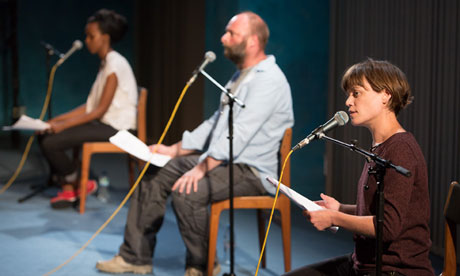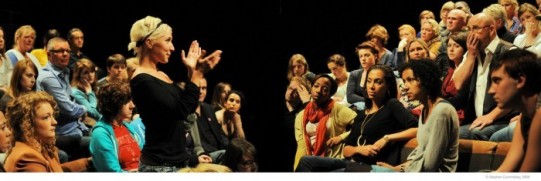Chris Thorpe on Form and the Audience – Written by Alex Summers, Literary Assistant
Royal Exchange Associate Artist, Chris Thorpe (THERE HAS POSSIBLY BEEN AN INCIDENT, CONFIRMATION) led this week’s workshop and turned our attention towards the relationship between a performance and the audience, to explore the possibilities of form and the potential impact theatre can have on those who encounter it.
Chris’s work as a writer and performer is expressly interested in theatre’s dynamic with an audience. To quote Simon Stephens, “In a Chris Thorpe play the audience is unapologetically acknowledged. The space of the theatre is unapologetically shared. The houselights stay on. The actors eyeball the punters. We are in the same place. We are here to share something together.”

There Has Possibly Been an Incident. Photograph: Jonathon Keenan
For Chris, limitless variety and imagination is demonstrated by all writers towards story, but form is very rarely interrogated, with the fourth wall often being employed by default to make for an isolated and comfortable audience.
Since live communication with a specific group of individuals is what makes theatre unique, it seems strange to ignore the variety of potential dynamics that present themselves when more thought is given to exploring a give and take relationship.
TAKE A LOOK AT THE TEXTThe Author by
With reference to Tim Crouch’s meta-theatrical experience, The Author, Chris urged us to see further than the traditional separation between performance and spectators that is usually employed when going to the theatre. To see is a passive experience, but here the audience is far more involved.
“The Author tells the story of another play: a violent, shocking and abusive play written by a playwright called Tim Crouch and performed at the Royal Court Jerwood Theatre Upstairs. The Author charts the effect that play had on the two actors who acted in it, the playwright who wrote it and an audience member who watched it. It also draws links to the broader world in which such a play could be written and presented; a world saturated by images of violence and governed by the media-distorted need for impact. It also examines the consequences of this mediated need in both art and the everyday.”
Tim Crouch on The Author
The Author features a story like any other play, but this story is about the theatre makers responsible for it—a self-referential reality where we see into the lives of a writer and actors. In the same way, the audience see into themselves at this performance; through the use of opposite seating banks in close proximity, the audience’s gaze is turned on one another.

The Author. Photograph: Tristram Kenton
To get at the heart of Tim Crouch’s methods, Chris encourages us to ask:
- What is it about?
- What is it for?
- What techniques does it use?
- How could it influence your own writing?
In discussion, we question whether this is even a ‘play’ or more an experience? Which leads us to realise how limited our perception of theatre can be at times. Meta-theatrical forms, which inherently acknowledge the audience as being part of the performance event, are often considered the province of devising companies or performance artists, but these tools should be utilised by playwrights in the same way as any other dramatic technique.
In the end we agree that the play’s ambitions can be interpreted in a great number of ways, but there is no doubt about its desire to make people change—the way we comfortably receive stories as a spectator, the assumptions we make; to have us think, rather than simply be entertained. The techniques used keep the audience awake, questioning the mechanics of theatre and the nature of the people you are sat next to.
Chris’s session ultimately make us question our default way of doing things. The traditional dynamic may well be right for the story you’re telling, but interrogate it first. Give thought to form, and never be tied to one in particular.
Apply this session to your own work and process
- Consider something you’re working on. How might you utilise an audience-performer dynamic which is different from the conventional default. Reimagine how it exists in the room with your audience, without any concern for practical limitations.
- Think of something you could ask the audience to give you at the performance e.g. a story, a piece of information, an action, some intervention…
- Consider how the audience will be different after seeing your show. What is it for?
“For an example of Chris Thorpe’s work check out, ‘There Has Possibly Been an Incident.”
TAKE A LOOK AT THE TEXT
Special thanks to Oberon Books for use of Tim Crouch’s ‘The Author’ and Chris Thorpe’s ‘There Has Possibly Been an Incident’”
The Royal Exchange Theatre gratefully acknowledges the generosity of the following for their support of Next Stages: The John S Cohen Foundation, The Garrick Club Charitable Trust and all those who supported the theatre’s recent Catalyst project, including public funding by the National Lottery through Arts Council England

